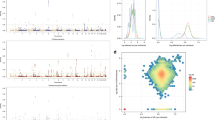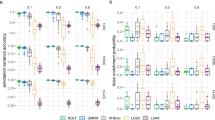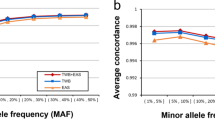Abstract
We previously published a series of detailed maps of single nucleotide polymorphisms (SNPs) in the genomic regions of 209 gene loci encoding drug metabolizing enzymes, transporters, receptors, and other potential drug targets. In addition to the maps reported earlier, we provide here high-resolution SNP maps of 23 genes encoding G-protein coupled receptors in the Japanese population. A total of 300 SNPs were identified through screening of these loci; 83 in four adenosine receptor family genes, 45 in three adrenergic receptor family genes, 22 in three EDG receptor family genes, 29 in three melanocortin receptor family genes, 22 in two somatostatin receptor family genes, 21 in five anonymous G protein-coupled receptor family genes, and 78 in the others (AVPR1B, OXTR, and TNFRSF1A). We also discovered a total of 33 genetic variations of other types. Of the 300 SNPs, 132 (44%) appeared to be novel on the basis of comparisons with the dbSNP database of the National Center for Biotechnology Information (US) or with previous publications. The maps constructed in this study will serve as an additional resource for studies of complex genetic diseases and drug-response phenotypes to be mapped by linkage-disequilibrium association analyses.
Similar content being viewed by others
Introduction
One of major goals in our laboratory is to establish “personalized medicine” on the basis of single nucleotide polymorphisms (SNPs) regarding responsiveness or adverse effects to drugs and susceptibility to common diseases. To achieve this aim, we have been conducting extensive screening programs to isolate SNPs in the Japanese population. Particularly, we have focused on SNP mapping in 209 genomic regions that correspond to genes involved in the metabolism of drugs and have constructed high-density SNP maps containing more than 6,500 genetic variations (Iida et al. 2001a,b,c,d,e, 2002a,b,c,d, 2003; Saito et al. 2001a,b, 2002a,b,c,d, 2003a,b; Sekine et al. 2001). Moreover, these efforts have allowed us to identify a total of five mutations that may affect the gene products, including two nonsense mutations in CYP genes and three frame-shift mutations (two in CYP genes and one in the MGST1 gene) among Japanese healthy donors (see a review by Iida and Nakamura 2003).
G-protein coupled receptors are cell-surface proteins and are responsible for the signal transduction for a variety of extracellular chemical signals such as photons, Ca2+, nucleotides, amino acids, peptides, amines, fatty derivatives, and various polypeptide ligands (see a review by Howard et al. 2001). On recognition of such ligands, these proteins mediate a variety of intracellular signals via activation of heterotrimeric G-proteins that in turn, activate various effector proteins, consequently resulting in a physiologic response for the cell (Marinissen and Gutkind 2001). G-protein coupled receptors are members of a large multigene family characterized by similar structure, which consists of seven alpha-helical transmembrane segments connected by three intracellular and three extracellular loops, an extracellular amino-terminal domain, and an intracellular carboxyl-terminal domain. So far, a large number of studies have reported genetic variations of G-protein coupled receptor gene loci and their role in etiology or predisposition of human diseases (Rana et al. 2001). G-protein coupled receptors are also considered to be good potential targets for drug development (Howard et al. 2001).
To expand the genetic basis for drug development as well as eventually to enable clinicians to predict efficacy and adverse drug reactions, we explored SNPs among 23 genes encoding G-protein coupled receptors. In this report, we provide high-resolution maps of these gene loci containing a total of 300 SNPs and 33 genetic variations of other types that we detected in DNAs from 48 Japanese volunteers.
Subjects and methods
Samples of peripheral blood were obtained with written informed consent form 48 healthy Japanese volunteers for this study. The SNP screening method described in an earlier report by Haga et al. (2002) was the principal technique applied in this study. In brief, on the basis of genomic sequences corresponding to each of the receptor genes from the GenBank database in the US National Center for Biotechnology Information (NCBI), we designed primers to amplify all selected genes in their entirety, excluding only regions that corresponded to repetitive sequences predicted by the RepeatMasker program (http://repeatmasker.genome.washington.edu/cgi-bin/RepeatMasker). All gene symbols mentioned through this report are according to the nomenclature in LocusLink of NCBI.
Each polymerase chain reaction (PCR) was performed using 20 ng of a mixture of genomic DNAs from three individuals. All 16 mixed samples were amplified in the GeneAmp PCR system 9700 (PE Applied Biosystems, Foster City, Calif., USA) under the following conditions: initial denaturation at 94°C for 2 min, followed by 35 cycles of denaturaion at 94°C for 30 s, annealing at 60°C for 30 s, extension at 72°C for 2 min, and post-extension at 72°C for 7 min. Products obtained from the PCR experiments served as templates for direct sequencing and detection of SNPs, using the fluorescent dye-terminator cycle-sequencing method. All SNPs detected by the polyphred computer program (Nickerson et al. 1997) were confirmed by sequencing both strands of each PCR product.
Results and discussion
By direct sequencing of DNA from 96 chromosomes, we screened SNPs in a total of approximately 174.4-kb genomic sequences that accounted for 60% of the 289.4-kb genomic region encompassing the loci of 23 selected genes, excluding the regions corresponding to human repetitive sequences. We identified a total of 333 variations, including 300 SNPs and 33 genetic variations of other types, and constructed a fine-scale SNP map of each locus (Fig. 1, Table 1). Detailed information for each variation identified in this study is summarized in Table 2. The overall genomic distribution of SNP was 1 in every 581 nucleotides in the 174.4-kb region that we sequenced. The overall frequencies of nucleotide substitutions in our test population were counted as 31% for A/G, 36.3% for C/T, 10% for C/G, 9.3% for T/G, 7.3% for A/C, and 6% for A/T; transitions occurred 2.1 times more frequently than transversions. By comparing SNPs detected in this study with previous reports from elsewhere (Sturm et al. 2001; Lubrano-Berthelier et al. 2003; Schalin-Jantti et al. 2003) or with the dbSNP database at NCBI, we were able to consider 132 of the 300 SNPs (44%) to be novel as of the end of December 2003.
Fine-scale single nucleotide polymorphism (SNP) maps of 23 gene loci encoding G-protein coupled receptors. Exons and introns are represented by rectangles and horizontal lines, respectively. SNPs are indicated above the lines (designations correspond to the left-most column of Table 1). Genetic variations of other types, where present, are indicated below the maps. However, the complete 5′ untranslated sequences and/or 3′ untranslated sequences of ADRA2B, EDG5, MC3R, MC4R, SSTR3, GPR3, and GPR10 were yet unidentified in database we used
We also identified two novel nonsense mutations in the Japanese healthy donors. One is a 322C→T (Arg108Stop) in ADORA3 belonging to adenosine receptor gene family. The other is a 706C→T (Arg236Stop) in an anonymous G protein-coupled receptor 1 gene. Both SNPs, each of which was identified in a single individual among the 48 volunteers tested, would be predicted to lack nearly half of the C-terminal part of each gene product. However, since these mutations were found in the healthy donors, we have no information regarding its potential effects on the carrier’s susceptibility to any diseases or drug responses. In all cases, more detailed genetic and functional studies will be necessary to clarify a relationship between these mutations and functional properties of these receptors.
Altogether, we have collected a total of 333 genetic variations, including 300 SNPs and 33 genetic variations of other types, among the 23 genes encoding G-protein coupled receptors by screening 96 Japanese chromosomes. We hope our SNP catalog can contribute to further investigations for identifying genes associated with drug efficacy and/or adverse drug reactions and for designing personalized medical care.
References
Dunnen JT den, Antonarakis SE (2000) Mutation nomenclature extensions and suggestions to describe complex mutations: a discussion. Hum Mutat 15:7–12
Haga H, Yamada R, Ohnishi Y, Nakamura Y, Tanaka T (2002) Gene-based SNP discovery as part of the Japanese Millennium Genome Project: identification of 190,562 genetic variations in the human genome. J Hum Genet 47:605–610
Howard AD, McAllister G, Feighner SD, Liu Q, Nargund RP, Van der Ploeg LH, Patchett AA (2001) Orphan G-protein-coupled receptors and natural ligand discovery. Trends Pharmacol Sci 22:132–140
Iida A, Nakamura Y (2003) Japanese efforts in pharmacogenomics. Curr Pharmacogenom 1:203–215
Iida A, Sekine A, Saito S, Kitamura Y, Kitamoto T, Osawa S, Mishima C, Nakamura Y (2001a) Catalog of 320 single nucleotide polymorphisms (SNPs) in 20 quinone oxidoreductase and sulfotransferase genes. J Hum Genet 46:225–240
Iida A, Saito S, Sekine A, Kitamoto T, Kitamura Y, Mishima C, Osawa S, Kondo K, Harigae S, Nakamura Y (2001b) Catalog of 434 single-nucleotide polymorphisms (SNPs) in genes of the alcohol dehydrogenase, glutathione S-transferase, and nicotinamide adenine dinucleotide, reduced (NADH) ubiquinone oxidoreductase families. J Hum Genet 46:385–407
Iida A, Saito S, Sekine A, Kitamura Y, Kondo K, Mishima C, Osawa S, Harigae S, Nakamura Y (2001c) High-density single-nucleotide polymorphism (SNP) map of the 150-kb region corresponding to the human ATP-binding cassette transporter A1(ABCA1 ) gene. J Hum Genet 46:522–528
Iida A, Saito S, Sekine A, Harigae S, Osawa S, Mishima C, Kondo K, Kitamura Y, Nakamura Y (2001d) Catalog of 46 single-nucleotide polymorphisms (SNPs) in the microsomal glutathione S-transferase 1 (MGST1) gene. J Hum Genet 46:590–594
Iida A, Saito S, Sekine A, Mishima C, Kondo K, Kitamura Y, Harigae S, Osawa S, Nakamura Y (2001e) Catalog of 258 single-nucleotide polymorphisms (SNPs) in genes encoding three organic anion transporters, three organic anion-transporting polypeptides, and three NADH: ubiquinone oxidoreductase flavoproteins. J Hum Genet 46:668–683
Iida A, Saito S, Sekine A, Mishima C, Kitamura Y, Kondo K, Harigae S, Osawa S, Nakamura Y (2002a) Catalog of 77 single-nucleotide polymorphisms (SNPs) in the carbohydrate sulfotransferase 1 (CHST1) and carbohydrate sulfotransferase 3 (CHST3) genes. J Hum Genet47:14–19
Iida A, Saito S, Sekine A, Kondo K, Mishima C, Kitamura Y, Harigae S, Osawa S, Nakamura Y (2002b) Thirteen single-nucleotide polymorphisms (SNPs) in the alcohol dehydrogenase 4 (ADH4) gene locus. J Hum Genet 47:74–76
Iida A, Saito S, Sekine A, Mishima C, Kitamura Y, Kondo K, Harigae S, Osawa S, Nakamura Y (2002c) Catalog of 605 single-nucleotide polymorphisms (SNPs) among 13 genes encoding human ATP-binding cassette transporters: ABCA4, ABCA7, ABCA8, ABCD1, ABCD3, ABCD4, ABCE1, ABCF1, ABCG1, ABCG2, ABCG4, ABCG5, and ABCG8. J Hum Genet 47:285–310
Iida A, Saito S, Sekine A, Mishima C, Kitamura Y, Kondo K, Harigae S, Osawa S, Nakamura Y (2002d) Catalog of 86 single-nucleotide polymorphisms (SNPs) in three uridine diphosphate glycosyltransferase genes: UGT2A1, UGT2B15, and UGT8. J Hum Genet 47:505–510
Iida A, Saito S, Sekine A, Mishima C, Kitamura Y, Kondo K, Harigae S, Osawa S, Nakamura Y (2003) Catalog of 668 SNPs detected among 31 genes encoding potential drug targets on the cell surface. J Hum Genet 48:23–46
Lubrano-Berthelier C, Cavazos M, Le Stunff C, Haas K, Shapiro A, Zhang S, Bougneres P, Vaisse C (2003) The human MC4R promoter: characterization and role in obesity. Diabetes 52:2996–3000
Marinissen MJ, Gutkind JS (2001) G-protein-coupled receptors and signaling networks: emerging paradigms. Trends Pharmacol Sci 22:368–376
Nickerson DA, Tobe VO, Taylor SL (1997) PolyPhred: automating the detection and genotyping of single nucleotide substitutions using fluorescence-based resequencing. Nucl Acids Res 25:2745–2751
Rana BK, Shiina T, Insel PA (2001) Genetic variations and polymorphisms of G protein-coupled receptors: functional and therapeutic implications. Annu Rev Pharmacol Toxicol 41:593–624
Saito S, Iida A, Sekine A, Eguchi C, Miura Y, Nakamura Y (2001a) Seventy genetic variations in human microsomal and soluble epoxide hydrolase genes (EPHX1 and EPHX2) in the Japanese population. J Hum Genet 46:325–329
Saito S, Iida A, Sekine A, Miura Y, Sakamoto T, Ogawa C, Kawauchi S, Higuchi S, Nakamura Y (2001b) Identification of 197 genetic variations in six human methyltranferase genes in the Japanese population. J Hum Genet 46:529–537
Saito S, Iida A, Sekine A, Miura Y, Ogawa C, Kawauchi S, Higuchi S, Nakamura Y (2002a) Three hundred twenty-six genetic variations in genes encoding nine members of ATP-binding cassette, subfamily B (ABCB/MDR/TAP), in the Japanese population. J Hum Genet 47:38–50
Saito S, Iida A, Sekine A, Miura Y, Ogawa C, Kawauchi S, Higuchi S, Nakamura Y (2002b) Identification of 779 genetic variations in eight genes encoding members of the ATP-binding cassette, subfamily C (ABCC/MRP/CFTR). J Hum Genet 47:147–171
Saito S, Iida A, Sekine A, Ogawa C, Kawauchi S, Higuchi S, Ohno M, Nakamura Y (2002c) 906 variations among 27 genes encoding cytochrome P450 (CYP) enzymes and aldehyde dehydrogenases (ALDHs) in the Japanese population. J Hum Genet 47:419–444
Saito S, Iida A, Sekine A, Ogawa C, Kawauchi S, Higuchi S, Nakamura Y (2002d) Catalog of 238 variations among six human genes encoding solute carriers (hSLCs) in the Japanese population. J Hum Genet 47:576–584
Saito S, Iida A, Sekine A, Kawauchi S, Higuchi S, Ogawa C, Nakamura Y (2003a) Catalog of 680 variations among eight cytochrome p450 (CYP) genes, nine esterase genes, and two other genes in the Japanese population. J Hum Genet 48:249–270
Saito S, Iida A, Sekine A, Kawauchi S, Higuchi S, Ogawa C, Nakamura Y (2003b) Catalog of 178 variations in the Japanese population among eight human genes encoding G protein-coupled receptors (GPCRs). J Hum Genet 48:461–468
Schalin-Jantti C, Valli-Jaakola K, Oksanen L, Martelin E, Laitinen K, Krusius T, Mustajoki P, Heikinheimo M, Kontula K (2003) Melanocortin-3-receptor gene variants in morbid obesity. Int J Obes Relat Metab Disord 27:70–74
Sekine A, Saito S, Iida A, Mitsunobu Y, Higuchi S, Harigae S, Nakamura Y (2001) Identification of single-nucleotide polymorphisms (SNPs) of human N-acetyltransferase genes NAT1, NAT2, AANAT, ARD1 and L1CAM in the Japanese population. J Hum Genet 46:314–319
Small KM, Brown KM, Forbes SL, Liggett SB (2001) Polymorphic deletion of three intracellular acidic residues of the alpha 2B-adrenergic receptor decreases G protein-coupled receptor kinase-mediated phosphorylation and desensitization. J Biol Chem 276:4917–4922
Sturm RA, Teasdale RD, Box NF (2001) Human pigmentation genes: identification, structure and consequences of polymorphic variation. Gene 277:49–62
Author information
Authors and Affiliations
Corresponding author
Rights and permissions
About this article
Cite this article
Iida, A., Saito, S., Sekine, A. et al. Catalog of 300 SNPs in 23 genes encoding G-protein coupled receptors. J Hum Genet 49, 194–208 (2004). https://doi.org/10.1007/s10038-004-0133-8
Received:
Accepted:
Published:
Issue Date:
DOI: https://doi.org/10.1007/s10038-004-0133-8
Keywords
This article is cited by
-
Polymorphisms in Adenosine Receptor Genes are Associated with Infarct Size in Patients with Ischemic Cardiomyopathy
Clinical Pharmacology & Therapeutics (2007)
-
Identification of 156 novel SNPs in 29 genes encoding G-protein coupled receptors
Journal of Human Genetics (2005)
-
Identification of 20 novel SNPs in the guanine nucleotide binding protein alpha 12 gene locus
Journal of Human Genetics (2004)






